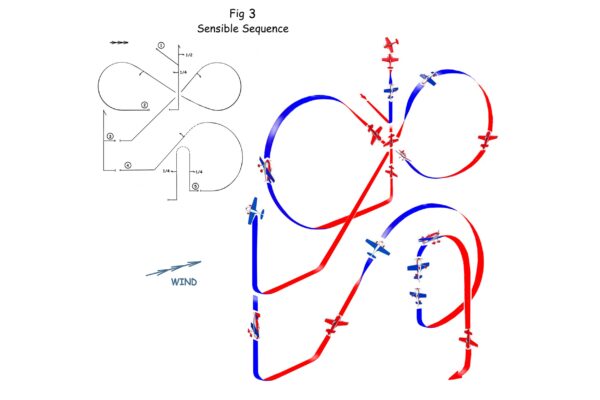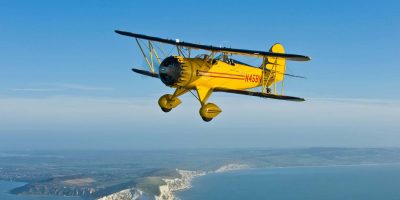Back in 2013 Brian Lecomber wrote his last column for FLYER. He passed away in September 2015, leaving the world poorer for his absence, but richer for the memories and writing he left behind. Brian spent many years on the circuit as a very accomplished member of the Rothmans aerobatic team, and of his own Firebird Aerobatic team.
In addition to his novels, Brian wrote about motoring and, of course, aviation. We’re reformatting his previous FLYER columns, this appeared in FLYER in February 2013.
Last time in the January issue of FLYER, we talked about the energy of an aeroplane – the stamina, as you might say – in aerobatics. We used mainly a simple loop as an example. Not theory – fact. We talked about how to save – or even gain – energy by using low g techniques whenever and wherever you can. How to scrape the last morsel of energy out of the bowl before Fagin (in the shape of high g) comes along and snatches the damn thing away again.
If you want to proceed further, the next step is of course stringing figures together to make a sequence. Not, on the face of it, a particularly harrowing demand. Just make sure your exit from manoeuvre (1) produces enough speed to enter manoeuvre (2) and so on, etc, etc…
Well – y-e-a-h…
In fact, not quite so simple as that. Not rocket science, no, no – but an endeavour strewn with enough potholes to make sequence-design something of an art in itself. Enough potholes, indeed, that as a Display Evaluator I am constantly astonished at the number of applicants who wilfully manage to put a foot in it not just once but several times.
Astonished, that is, until I remember the times I did exactly the same thing myself. Time and time again…
So let us look at sequence design.
The first important thing to hoist in is that just as our loop – one figure – had an energy quotient, then so does an entire aerobatic sequence. It follows on. If part of the loop is wrong – you will lose energy. If part of a sequence is ill-advised you will – lose energy.
So Rule One is do not try to be too clever. If your sequence starts high and drifts down then you ARE trying to be too clever. You are putting in too much complication (aka drag) and sooner or later you’ll make a (maybe small) mistake or inexactitude which will cost you energy and height. And also possibly render you extinct.
My credo has always been that there is only one place in a sequence for that Armageddon-meister-whifferdill which you’re ever so proud of, but which requires a start-speed of Velocity Never Exceed-plus-mumble. And that is as the opening manoeuvre. This is the only time you can guarantee VNE in a sequence, and the only time you can visually get away with pulling up from a bit higher than your normal base-height. The rest of the display MUST bounce up and down from base-height. (Whatever that height may be.)
Which leads to a second pothole which I see fairly frequently nowadays. A pilot with more money than experience buys a modern aerobatic hot-ship and then concentrates on developing a few Armageddon manoeuvres – lomcovaks, knife-edge rotations and the like – before he can accurately fly the basics, such as a clean up-vertical roll.
This leads to two or three super-figures (or what the guy thinks are super-figures) in a display, with said figures surrounded by boring, usually rather inaccurate and sprawling shapes, which he finds himself in need of to work up speed for the next big whammo. This is like watching Gone With The Wind with patches of Terminator II inserted in it – it simply does not work visually, and again can lead to personal premature obsolescence.
Which is not to say you should ignore the differing energy requirements of various manoeuvres – oh, dearie me, no. Very, very far from it. Very far indeed.
Just as speeding fines vary according to the actual velocity of the sinner, so do aerobatic figures vary in the degree of aerodynamic drag involved in their execution.
For a simple example, take a straightforward loop compared with an avalanche – an avalanche being a loop with a flick-roll (snap-roll, if you are of American persuasion) added in at the top. You might enter the unadorned loop at (say) 100kt, float over the top in low drag, and bottom-out at maybe 110kt or even more.
The avalanche, on the other hand, will call for a higher start-speed in the first place – call it 120kt – in order to arrive near the top with enough energy for a decent flick. And secondly will be sacrificing almost all of the simple loop’s low-drag top-arc on the same altar of the flick-roll. So the avalanche may exit at 90kt…
In short, in this case the simple loop is a 10kt energy-gainer, while the avalanche is a 30kt energy-burner. Other manoeuvres may be energy-neutral – the figure starting and finishing at much the same speed. Just what these manoeuvres might be obviously varies hugely with aircraft type – but the principle will always be true. There will always be the same triad – energy burners, neutrals and gainers.
Which brings us to what I think of as aerobatic median speed. Not medium – median. The speed-range within which a given aeroplane will tend to bottom-out figures in a sequence. This will be notably below VNE – in a Pitts S2-A, for example, with a VNE of 201mph, the median speed range is something like 130 to 150mph.
It follows, then, that if you’ve just flown an energy-burner entered at the top end of the median speed-range, 150mph, you can expect to finish with an exit-speed down to maybe 130mph. So then you need an energy-gainer – say, a simple stall-turn – which may start at 130mph but exit at 140. Followed possibly by an energy-neutral figure which starts at 140 and finishes at 140.
So the flow of your sequence becomes something like; burner… neutral… gainer… burner… gainer… Most clearly, any sequence which at any stage calls for burner… burner… burner – is not good for the health.
(As a very rough rule of thumb your max-power straight and level speed will tend to be towards the top end of the median aerobatic speed-range. This is not universal, but may help as a starting-point.)
Rule Two is to think of smallness. All performances – and it doesn’t matter if you’re a solo Tiger Moth or the Red Arrows – always look best when they occupy the smallest possible box of sky.
OK – so how do you design a compact sequence? The official display ‘box’ for aerobatic competitions is a cube of atmosphere 1km long on all sides. The faster your aeroplane – obviously – the more difficult it is to stay in the box. In a slower machine it is easier – but being, well, slower, perhaps you should be aiming at a slightly smaller box?
In any event, the principles are the same.









